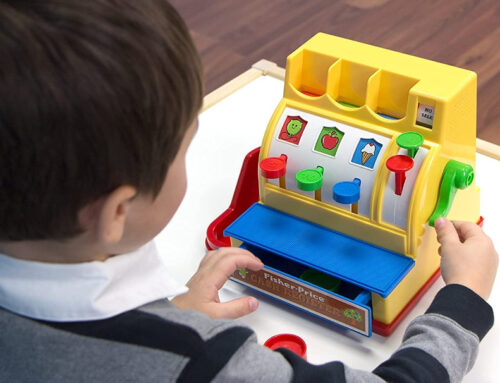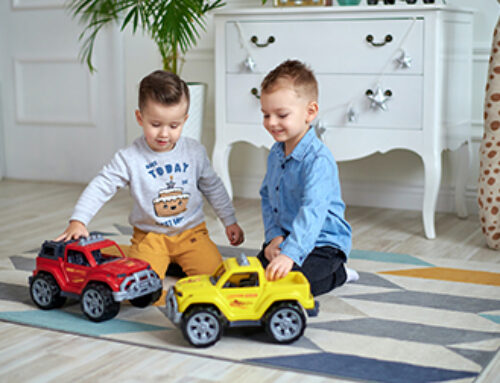Don’t Break the Ice! This is a favorite for kids of many ages, easily adjusted to a variety of skills levels. It can be a great way to introduce turn-taking and playing games with rules in a fun and silly way.
Areas of Development:
- Communication: This can be a great time to work on the concept of “your turn” vs. “my turn,” while engaged in play. Pairing gestural cues with your words can help your child understand the concept and begin to pair the words with that concept. For kids with higher level language, you can ask questions about what is happening in the game as opposed to narrating for them.
- Gross Motor: Promote postural control and proximal shoulder stability by encouraging your child to lay on their belly while playing this game. It can be helpful to model this position, laying on your belly while playing as well! Your child may need some additional tactile cues (hand on their back or hips) to help maintain this position for longer intervals. If your child is a mover, you can incorporate movement into each turn, having to “earn” the hammer back by performing a short gross motor task, such as jumping up and down 5 times or rolling across the floor.
- Fine Motor: Don’t Break the Ice is a great game to work on fine motor control and gradation of force. Using the small hammer helps promote isolated wrist movement, an important skill for self-feeding and utensil use. Encourage your child to use only one hand at a time to grasp the hammer.
- Social Emotional: This is a simple cause-and-effect game with rules and turn-taking. While it may take a few trials, this is a fun way to teach your child to wait for their turn while promoting joint attention through play. Use of high affect and slightly exaggerated reactions can help draw your child in and promote participation.
- Cognition: This game is called “Don’t Break the Ice,” although it can be so very fun to break the ice. Understanding the concept of “don’t” and how to win the game is a great way to practice this concept. You can also work on counting how many blocks fall each round, modeling for your child. It can be helpful to line up the blocks to promote counting from left to right to increase accuracy.

Upgrade: Have your child play with another child or sibling. Having three people play means you will need to wait longer for each turn and also have a higher chance of being the one to break the ice if force gradation is a challenge. This can help your child target frustration tolerance, patience, and turn-taking. You can also have your child restack the “ice” blocks into the stand to increase the challenge between each round.
Downgrade: If your child isn’t ready for turn-taking or for gameplay with specific rules, you can adjust the game while still targeting many skills. Start by encouraging your child to hold the hammer and knocking down the blocks. You can then have your child “earn” the hammer back by completing gross motor activities (refer to gross motor section). Work on sustained attention to task, working towards turn-taking and understanding the original rules of the game.
Additional Games:

Blue Bird Day fosters socialization, sensory regulation, and pre-academic learning in children ages 2-7 years in therapeutic rotations that simulate preschool and kindergarten settings. Our compassionate therapists practice a relationship-based and family-centered approach, provide parent training, and collaborate on goals and individualized intensive treatment plans for your child.
We believe in a collaborative and multi-disciplinary team approach to therapy. A team of occupational therapists, speech-language pathologists, dietitians, developmental therapists, behavioral therapists, physical therapists, and therapeutic assistants are created for each child to ensure child and family are fully supported and the best possible results are achieved.
Options for individualized, group and virtual therapy sessions are available as well.
Want to learn more or you have a specific question? Feel free to connect with us here!



